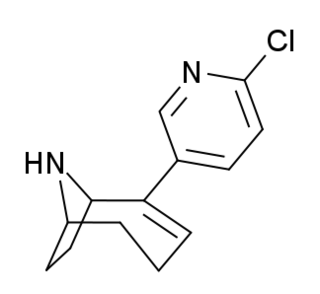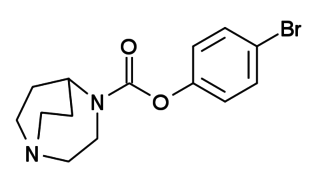A parasympathomimetic drug, sometimes called a cholinomimetic drug or cholinergic receptor stimulating agent, is a substance that stimulates the parasympathetic nervous system (PSNS). These chemicals are also called cholinergic drugs because acetylcholine (ACh) is the neurotransmitter used by the PSNS. Chemicals in this family can act either directly by stimulating the nicotinic or muscarinic receptors, or indirectly by inhibiting cholinesterase, promoting acetylcholine release, or other mechanisms.

SKF-82,958 is a synthetic compound of the benzazepine class that acts as a D1/D5 receptor full agonist. SKF-82,958 and similar D1-like-selective full agonists like SKF-81,297 and 6-Br-APB produce characteristic anorectic effects, hyperactivity and self-administration in animals, with a similar but not identical profile to that of dopaminergic stimulants such as amphetamine. SKF-82,958 was also subsequently found to act as an agonist of ERα with negligible activity at ERβ, making it a subtype-selective estrogen.
The alpha-2 (α2) adrenergic receptor is a G protein-coupled receptor (GPCR) associated with the Gi heterotrimeric G-protein. It consists of three highly homologous subtypes, including α2A-, α2B-, and α2C-adrenergic. Some species other than humans express a fourth α2D-adrenergic receptor as well. Catecholamines like norepinephrine (noradrenaline) and epinephrine (adrenaline) signal through the α2-adrenergic receptor in the central and peripheral nervous systems.
Melanocortin receptors are members of the rhodopsin family of 7-transmembrane G protein-coupled receptors.

Metaraminol, also known as metaradrine, a stereoisomer of meta-hydroxynorephedrine (3,β-dihydroxyamphetamine), is a potent sympathomimetic amine used in the prevention and treatment of hypotension, particularly as a complication of anesthesia. It is an α1-adrenergic receptor agonist with some β effect.

Alpha-adrenergic agonists are a class of sympathomimetic agents that selectively stimulates alpha adrenergic receptors. The alpha-adrenergic receptor has two subclasses α1 and α2. Alpha 2 receptors are associated with sympatholytic properties. Alpha-adrenergic agonists have the opposite function of alpha blockers. Alpha adrenoreceptor ligands mimic the action of epinephrine and norepinephrine signaling in the heart, smooth muscle and central nervous system, with norepinephrine being the highest affinity. The activation of α1 stimulates the membrane bound enzyme phospholipase C, and activation of α2 inhibits the enzyme adenylate cyclase. Inactivation of adenylate cyclase in turn leads to the inactivation of the secondary messenger cyclic adenosine monophosphate and induces smooth muscle and blood vessel constriction.

The alpha-7 nicotinic receptor, also known as the α7 receptor, is a type of nicotinic acetylcholine receptor implicated in long-term memory, consisting entirely of α7 subunits. As with other nicotinic acetylcholine receptors, functional α7 receptors are pentameric [i.e., (α7)5 stoichiometry].

DPI-221 is an opioid drug that is used in scientific research. It is a highly selective agonist for the δ-opioid receptor, which produces fewer convulsions than most drugs from this family.

DPI-3290 was discovered by scientists at Burroughs Wellcome and licensed to Delta Pharmaceutical and is a drug that is used in scientific research. It is a potent analgesic drug, which produces little respiratory depression.

Pozanicline is a drug developed by Abbott, that has nootropic and neuroprotective effects. Animal studies suggested it useful for the treatment of ADHD and subsequent human trials have shown ABT-089 to be effective for this application. It binds with high affinity subtype-selective to the α4β2 nicotinic acetylcholine receptors and has partial agonism to the α6β2 subtype, but not the α7 and α3β4 subtypes familiar to nicotine. It has particularly low tendency to cause side effects compared to other drugs in the class, making it an exciting candidate for clinical development.

Cholecystokinin tetrapeptide (CCK-4, Trp-Met-Asp-Phe-NH2) is a peptide fragment derived from the larger peptide hormone cholecystokinin. Unlike cholecystokin which has a variety of roles in the gastrointestinal system as well as central nervous system effects, CCK-4 acts primarily in the brain as an anxiogenic, although it does retain some GI effects, but not as much as CCK-8 or the full length polypeptide CCK-58.

4-NEMD is a potent sedative drug which acts as a selective alpha-2 adrenergic agonist. It is closely related to dexmedetomidine but is several times more potent. Like other alpha-2 agonists, it produces sedative and muscle relaxant effects but without producing respiratory depression. It is not currently used in medicine but has been researched as the basis for a potential new generation of alpha-2 agonist drugs, which may have selectivity for the different subtypes of the alpha-2 receptor. It has two isomers, with the (S) isomer being the more potent, as with medetomidine. 4-NEMD was also investigated by the United States military as an anaesthetic agent, most likely for use in surgery but possibly also for use as a non-lethal incapacitating agent, although this has not been officially confirmed.

L-655,708 (FG-8094) is a nootropic drug invented in 1996 by a team working for Merck, Sharp and Dohme, that was the first compound developed which acts as a subtype-selective inverse agonist at the α5 subtype of the benzodiazepine binding site on the GABAA receptor. It acts as an inverse agonist at the α1, α2, α3 and α5 subtypes, but with much higher affinity for α5, and unlike newer α5 inverse agonists such as α5IA, L-655,708 exerts its subtype selectivity purely via higher binding affinity for this receptor subtype, with its efficacy as an inverse agonist being around the same at all the subtypes it binds to.

SH-053-R-CH3-2′F is a drug used in scientific research which is a benzodiazepine derivative. It produces some of the same effects as other benzodiazepines, but is much more subtype-selective than most other drugs of this class, having high selectivity, binding affinity and efficacy at the α5 subtype of the GABAA receptor. This gives much tighter control of the effects produced, and so while SH-053-R-CH3-2′F retains sedative and anxiolytic effects, it does not cause ataxia at moderate doses. SH-053-R-CH3-2′F also blocks the nootropic effects of the α5-selective inverse agonist PWZ-029, so amnesia is also a likely side effect.

RDS-127 is a drug which is used in scientific research. It acts as a D2-like receptor agonist and also has some serotonin and adrenergic agonist effects, as well as some anticholinergic action, and produces both anorectic and pro-sexual effects in animal studies.

UB-165 is a drug which acts as an agonist at neuronal nicotinic acetylcholine receptors being a full agonist of the α3β2 isoform and a partial agonist of the α4β2* isoform. It is used to study the role of this receptor subtype in the release of dopamine and noradrenaline in the brain, and has also been used as a lead compound to derive a number of other selective nicotinic receptor ligands.

PNU-282,987 is a drug that acts as a potent and selective agonist for the α7 subtype of neural nicotinic acetylcholine receptors. In animal studies, it shows nootropic effects, and derivatives may be useful in the treatment of schizophrenia, although PNU-282,987 is not suitable for use in humans because of excessive inhibition of the hERG antitarget. PNU-282987 has been shown to initiate signaling that leads to adult neurogeneis in mammals.

SSR180711 is a drug that acts as a potent and selective partial agonist for the α7 subtype of neural nicotinic acetylcholine receptors. In animal studies, it shows nootropic effects and may be useful in the treatment of schizophrenia.

A-366,833 is a drug developed by Abbott, which acts as an agonist at neural nicotinic acetylcholine receptors selective for the α4β2 subtype, and has been researched for use as an analgesic, although it has not passed clinical trials. Its structure has a nicotinonitrile (3-cyanopyridine) core bound through C5 to the N6 of (1R,5S)-3,6-diazabicyclo[3.2.0]heptane.

Allopregnanediol, or 5α-pregnane-3α,20α-diol, is an endogenous metabolite of progesterone and allopregnanolone and an isomer of pregnanediol (5β-pregnan-3α,20α-diol). It has been found to act like a partial agonist of an allosteric site of the GABA receptor and hence might play a biological role as a neurosteroid. It has also been found to act as an agonist of the human pregnane X receptor, albeit with an EC50 that is more than an order of magnitude lower than that of other endogenous pregnanes like pregnenolone, pregnanediol, allopregnanedione, and allopregnanolone.

















